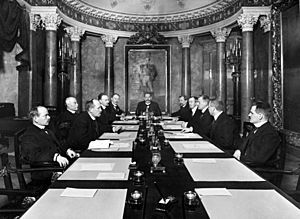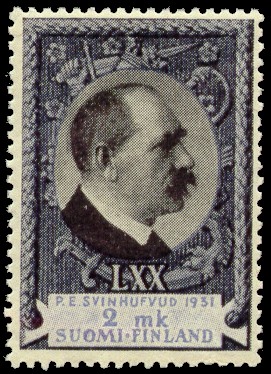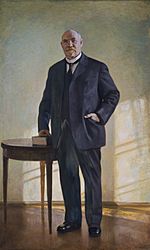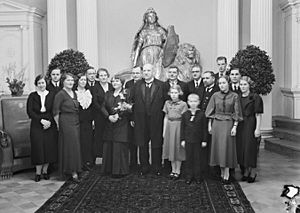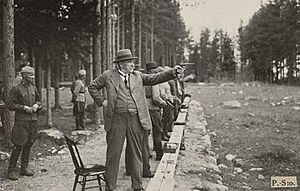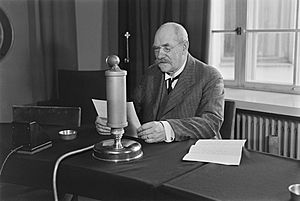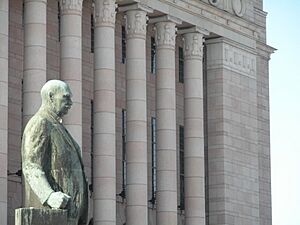Pehr Evind Svinhufvud facts for kids
Quick facts for kids
Pehr Evind Svinhufvud
|
|
|---|---|
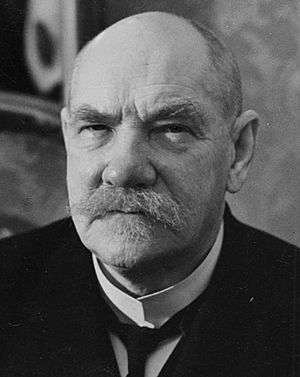
Pehr Evind Svinhufvud during the Interwar Years
|
|
| 3rd President of Finland | |
| In office 2 March 1931 – 1 March 1937 |
|
| Prime Minister | Juho Sunila Toivo Mikael Kivimäki Kyösti Kallio |
| Preceded by | Lauri Kristian Relander |
| Succeeded by | Kyösti Kallio |
| Prime Minister of Finland | |
| In office 4 July 1930 – 18 February 1931 |
|
| President | Lauri Kristian Relander |
| Preceded by | Kyösti Kallio |
| Succeeded by | Juho Sunila |
| In office 27 November 1917 – 27 May 1918 |
|
| Preceded by | Position established |
| Succeeded by | Juho Kusti Paasikivi |
| State Regent of Finland | |
| In office 18 May 1918 – 12 December 1918 |
|
| Preceded by | Position established |
| Succeeded by | Gustaf Mannerheim |
| Chairman of the Senate of Finland | |
| In office 27 November 1917 – 27 May 1918 |
|
| Preceded by | Eemil Nestor Setälä |
| Succeeded by | Juho Kusti Paasikivi |
| Personal details | |
| Born |
Pehr Evind Svinhufvud af Qvalstad
15 December 1861 Sääksmäki, Grand Duchy of Finland, Russian Empire |
| Died | 29 February 1944 (aged 82) Luumäki, Republic of Finland |
| Political party | Young Finnish Party (before 1918) National Coalition Party (after 1918) |
| Spouse | Ellen Timgren |
| Children | Pehr Yngve, Ilmo Gretel, Aino Mary Alfthan, Eino Gustaf, Arne Bertel and Veikko Eivind
|
| Alma mater | Imperial Alexander University (now University of Helsinki) |
| Occupation | Lawyer, Judge |
| Signature | |
| Nickname | Ukko-Pekka |
Pehr Evind Svinhufvud (1861–1944) was a very important person in Finland's history. He was the third President of Finland, serving from 1931 to 1937. Before becoming president, he worked as a lawyer and a judge. He played a huge part in helping Finland become an independent country.
Svinhufvud was the one who presented Finland's Declaration of Independence to the Parliament in 1917. He was also the first Head of State of independent Finland. People sometimes called him Ukko-Pekka, which means "Old Man Pekka". He was known for being a conservative and a nationalist. He strongly disagreed with communism.
Contents
Early Life and Family History
Pehr Evind Svinhufvud was born in Sääksmäki, Finland, in 1861. His father was a sea captain who sadly drowned when Pehr Evind was only two years old. He grew up with his grandfather in a place called Rapola. His family, the Svinhufvuds, were a noble family from Sweden. Their name means "Swine-head"!
The family had lived in Rapola for five generations. After his grandfather passed away in 1866, Svinhufvud moved to Helsinki with his mother and sister.
Education and Marriage
He went to a Swedish-language high school in Helsinki. At 16, he started studying at the Imperial Alexander University of Helsinki. He earned a Bachelor's degree in 1881 and a Master of Arts degree in 1882. His main subjects were Finnish, Russian, and Scandinavian History. Later, he also got a Master of Laws degree in 1886.
In 1889, Svinhufvud married Ellen Timgren. They had six children together: Yngve, Ilmo Gretel, Aino Mary, Eino, Arne, and Veikko.
A Career in Law and Politics
Svinhufvud started his career as a lawyer and judge. In 1892, he joined the Senate's law-drafting committee. This was a big role for someone so young. He worked there for six years, helping to rewrite laws, especially about taxes.
He also took part in the Diet of Finland, which was like an old parliament. He represented the noble families from 1894 to 1906.
Standing Up for Finland's Rights
Things changed around 1899 when Imperial Russia started trying to make Finland more Russian. Finland was an independent Grand Duchy at the time. Many Finns, including Svinhufvud, resisted this. He became a key figure in this resistance as a judge.
In 1902, some people complained about the Russian Governor of Uusimaa. The court, including Svinhufvud, started a case against the Governor-General. The Governor-General demanded they stop. When they refused, he used a decree that Finns thought was illegal to fire sixteen court officials, including Svinhufvud.
After being fired, Svinhufvud became a strong supporter of Finland's own laws and constitution. He believed it was a matter of justice, not politics. He moved to Helsinki and continued his work as a lawyer. He also joined a secret society called Kagal, which worked against Russian rule.
Becoming a Member of Parliament
Svinhufvud helped create Finland's new parliamentary system in 1905. He was elected to the new Parliament in 1906 as a member of the Young Finnish Party. He served in Parliament several times between 1907 and 1931.
He became the Speaker of Parliament in 1907. He was chosen because many people saw him as a strong opponent of Russia's illegal actions. His speeches, which focused on Finnish law, led to the Tsar dissolving Parliament in 1909 and 1910. He remained Speaker until 1912.
Exile in Siberia
During World War I, Russia replaced many Finnish officials with Russians. Svinhufvud refused to follow orders he thought were illegal. Because of this, he was removed from his job as a judge and sent away to Tomsk in Siberia in 1914.
While in Siberia, he secretly stayed in touch with the Finnish independence movement. He famously said he would return "with the help of God and Hindenburg" (a German general). When he heard about the Russian Revolution in 1917, he simply told the police, "The person who sent me here has been arrested. Now I'm going home." He returned to Finland as a national hero.
Finland's Independence and Civil War

On November 27, 1917, Svinhufvud became the Chairman of the Senate. He was a key person in Finland's declaration of independence on December 6, 1917. He even traveled to Russia to meet Vladimir Ilyich Lenin, who officially recognized Finland's independence.
Svinhufvud's government also allowed General Mannerheim to create a new Finnish army. This happened at the same time as the start of the Civil War in Finland. During the war, Svinhufvud had to hide in Helsinki. He asked Germany and Sweden for help.
In March 1918, he managed to escape to Vaasa, where the Senate had moved. He continued his role as Head of Government. After the war, he pardoned many prisoners. On May 18, 1918, Svinhufvud became the Protector of State, or Regent, which meant he was the Head of State.
After Germany lost World War I, Finland's plan to become a monarchy failed. Svinhufvud then stepped back from public life for a while. He remained active in the anti-communist Suojeluskunta militia.
Prime Minister and President of Finland
In 1925, he ran for president but was not elected. Later, in 1930, a group called the Lapua Movement became very strong. They were against communism. Because of their demands, President Relander appointed Svinhufvud as Prime Minister of Finland.
Svinhufvud was elected President in 1931. He appointed Mannerheim as Chairman of the Defence Council. This was partly to show the Lapua Movement that their fight in the Civil War was not in vain.
He stood strong against both communist groups and the Lapua Movement. All communist members of parliament were arrested. In February 1932, there was a rebellion called the Mäntsälä Rebellion. The Suojeluskunta militia and the Lapua Movement demanded the government resign. Svinhufvud gave a powerful speech that stopped the rebellion before it caused serious trouble.
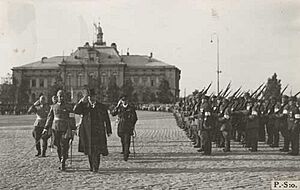
Svinhufvud believed the President should have a strong role in choosing government ministers. He supported a minority government led by Toivo M. Kivimäki for almost four years. He thought this government could fight the Great Depression well. He also wanted to keep the Social Democrats, Finland's largest political party, out of the government. He worried they would make too many radical changes.
In the 1937 Presidential election, the Social Democrats and the Agrarian party voted against him. He was not re-elected.
Later, during the Winter War, he tried to meet with Adolf Hitler and Benito Mussolini but only met Pope Pius XII. During the Continuation War, he supported the idea of Finland expanding its territory.
Svinhufvud's favorite hobbies were hunting and precision shooting. He passed away in Luumäki in 1944, while Finland was trying to make peace with the Soviet Union. He never changed his family's 500-year-old noble name to a Finnish one.
Honours
| Coat of Arms of Pehr Evind Svinhufvud | |
|---|---|
 |
|
| Armiger | Pehr Evind Svinhuvud |
Awards and Decorations
 Finland : Grand Cross with Collar of the Order of the White Rose (Finland) (1927)
Finland : Grand Cross with Collar of the Order of the White Rose (Finland) (1927) Finland : Grand Cross of the Order of the Cross of Liberty (1918)
Finland : Grand Cross of the Order of the Cross of Liberty (1918) Czechoslovakia : Collar of the Order of the White Lion, Czechoslovakia (1931)
Czechoslovakia : Collar of the Order of the White Lion, Czechoslovakia (1931) Sweden : Knight of the Order of the Seraphim, Sweden (1932)
Sweden : Knight of the Order of the Seraphim, Sweden (1932) Poland : Order of the White Eagle
Poland : Order of the White Eagle Estonia : Order of the Cross of the Eagle
Estonia : Order of the Cross of the Eagle Hungary : Order of Merit of the Kingdom of Hungary
Hungary : Order of Merit of the Kingdom of Hungary Egypt : Chain of the Order of Muhammad Ali (1936)
Egypt : Chain of the Order of Muhammad Ali (1936) Latvia : Grand Gross with Collar of the Order of the Three Stars (1931)
Latvia : Grand Gross with Collar of the Order of the Three Stars (1931)
Images for kids
-
Kotkaniemi, a former home of President Svinhufvud and current museum, in Luumäki, South Karelia.
See also
 In Spanish: Pehr Evind Svinhufvud para niños
In Spanish: Pehr Evind Svinhufvud para niños
- Finnish Declaration of Independence
- Ukko-Pekka (locomotive)


